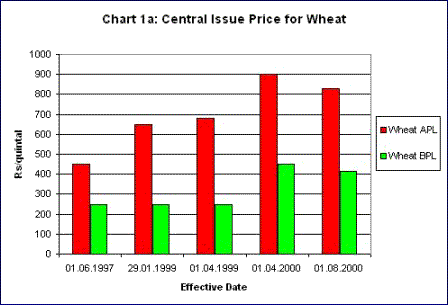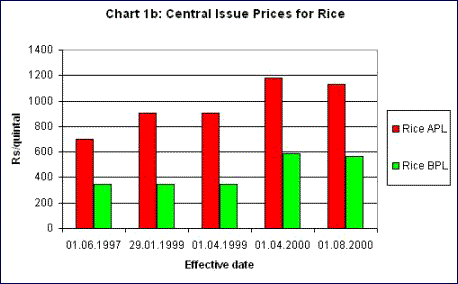|
The
paradox of poverty amidst plenty, which has been so
characteristic of the Indian economy over the 1990s,
seems especially marked with respect to the foodgrain
sector at the moment. Last year had witnessed record
foodgrain production, especially of wheat and rice.
But, measures designed to reduce the budgeted food subsidy
had led to substantial increases in the prices of foodgrain
in the Public Distribution System (PDS) (chart 1a &
1b). This caused PDS offtake to fall (chart 2) and food
stocks held by the public sector to grow (chart 3),
at the cost of availability in the market. Also, as
a result, foodgrain prices increased at double digit
level for yet another year, despite the record production
(chart 4).

Chart
1a >> Click
to Enlarge

Chart
1b >> Click
to Enlarge

Chart
2 >> Click
to Enlarge

Chart
3 >> Click
to Enlarge

Chart
4 >> Click
to Enlarge
And, far from being reduced, food
subsidies actually increased, precisely because higher
administered prices led to much higher stocks, increasing
the costs of holding these (chart 5). While the knock-on
effect of higher PDS prices on market prices is well
acknowledged, what is not equally understood is that
under current circumstances this is also likely to increase,
not decrease, the food subsidy. Such subsidy cuts are
therefore totally counterproductive, hurting both consumers
and the fisc, as had been pointed out in this column
shortly after last year's PDS price hike (Macroscan,
February, 9th 1999).

Chart
5 >> Click
to Enlarge
However,
such is the intellectual lethargy in North Block that,
faced with a situation when food subsidies had increased
when they had expected a reduction, the Finance Minister's
advisors could offer no other solution than to increase
PDS prices further, by linking these to the Food Corporation
of India's economic cost of grain procured. Somehow,
political antennae in government were also in sleep
mode, so that this proposal got incorporated into Budget
2000-2001. At that point the NDA allies had called foul,
but they could not go beyond their populist instincts
and question the government on how a further hike in
PDS prices this year would reduce the subsidy bill,
given that these subsidies had actually increased following
last year's price increases. Probably because of past
humiliation on account of rollbacks, Finance Minister
Yashwant Sinha also chose to make this an issue on which
he stuck to his guns, to much kudos from the pink press,
but of course with necessary political concessions elsewhere.
One of these concessions to allies was to increase the
Minimum Support Price (MSP) for wheat from Rs 550 per
quintal to Rs 580 per quintal, totally against the recommendation
of the Commission for Agricultural Costs and Prices
that there be no further increase in the MSP. This Commission,
which has been overruled on the matter for three years
in a row, appears now to have become totally irrelevant
as far as wheat pricing is concerned. Indeed, again
contrary to the Commission's repeated exhortation that
MSPs be announced before sowing, the announcement this
year was made only after the budget in February, by
when the grain was near harvesting.
Thus, the populist announcement of an enhanced MSP did
nothing towards encouraging farmers to produce more.
But it did have two other effects. First, it
encouraged larger diversion of harvest arrivals from
private trade to government agencies, and, as a result,
wheat procurement during April-June 2000-2001 reached
a record, crossing 16 million tonnes (chart 6). Secondly,
with the budget having linked PDS prices automatically
to the economic cost, these increased with the higher
MSP.

Chart
6 >> Click to Enlarge
|

